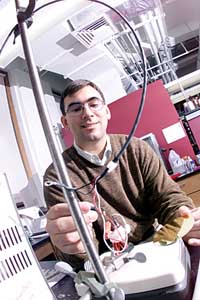Chemical method makes further investigation of carbohydrates possible
By Steve KoppesNews Office
 Milan Mrksich, Associate Professor in Chemistry. |
University scientists have described the first chip-based chemical strategy for rapidly screening carbohydrates for biologically useful activity.
The technique enables researchers to scan a single chip for literally thousands of different biologically active compounds that could someday play a key role in the treatment of disease or as a diagnostic for biological warfare agents.
Milan Mrksich, Associate Professor in Chemistry, and Benjamin Houseman, (Ph.D. ’01), a student in the Pritzker School of Medicine, report their method in the April issue of the journal Chemistry and Biology.
“The work on carbohydrate arrays by Milan Mrksich and coworkers is of great significance for the emerging field of glycomics,” said Peter Seeberger, the Fermenich assistant professor of chemistry at the Massachusetts Institute of Technology.
“To date, no chemically defined carbohydrate array had been produced. The paper in Chemistry and Biology is the first example that addresses this important need.”
During the past decade, scientists have developed biochips that allow them to rapidly assess vast arrays of genes for their drug-development potential, and they are on the way to doing likewise for proteins. But until now, they had no efficient way to test large arrays of carbohydrates, another major class of biological molecules. It has proven more difficult to study the role of carbohydrates in biology than it has been for either genes or proteins, Mrksich said.
“Carbohydrates have more complex structures, so we still don’t know how to synthesize them in an efficient way. And because of that, studies of carbohydrate biology have lagged far behind studies of proteins and DNA in biology,” he said.
“As we learn about the important roles that carbohydrates play in biology, it’s going to create a demand for screening tools or chip-based assays for investigating biological functions of carbohydrates.”
In their carbo-chip production process, Mrksich and Houseman chemically tie down the carbohydrates to the surface of the chip and apply a solution of proteins. A half-hour later they rinse the chip, then image it with fluorescence. The spot on the chip where there is no fluorescent glow is the spot where the proteins failed to bind with the carbohydrates.
This is important because most pharmaceutical drug-development programs are based on attempts to identify small molecules that interrupt protein or enzyme function.
“Knowing where the spot is, we can identify the compound that blocked the protein-carbohydrate binding interaction. That compound becomes a drug-lead, because it has selective activity against protein-binding,” Mrksich said.
False signals frustrated previous efforts to identify the active compounds because proteins tended to stick indiscriminately to the chips. Mrksich and Houseman get around that prob-lem with chemical reactions that bind only the desired compounds to the chips.
Although many functions of carbohydrates remain unknown and await further study, they do play a role in cancer and other diseases.
“Cancer cells express different carbohydrates on their surfaces than do normal cells,” Mrksich said. “That means that the carbohydrates can provide a selective way of targeting cancer cells with drugs while not targeting healthy cells.”
The Defense Advanced Research Projects Agency and the University’s Materials Research Science and Engineering Center support Mrksich’s work. The DARPA funding stems from the agency’s interest in the detection of bio-warfare agents. Mrksich will soon begin collaborating with U.S. Department of Defense laboratories to investigate the possibility of using carbohydrate chips for identifying bio-warfare agents in blood samples of potential victims.
“When we’re infected with a bacterium or a virus, our immune system mounts a response,” Mrksich said. In many cases, the response is directed against the carbohydrates that are on the surface of the bacterium or virus in question. “The immune system will develop antibodies that are targeted against that carbohydrate,” he said. The assays can then reveal the infectious agent by identifying which carbohydrate-attacking antibodies are present in the sample.
Mrksich estimates that reliable, commercially produced carbohydrate chips will become widely available in less than five years, slightly ahead of protein chips.
“There are a larger number of problems that can be addressed with protein chips,” Mrksich said. “But carbohydrate chips will be very important for a large set of problems.”
![[Chronicle]](/images/small-header.gif)